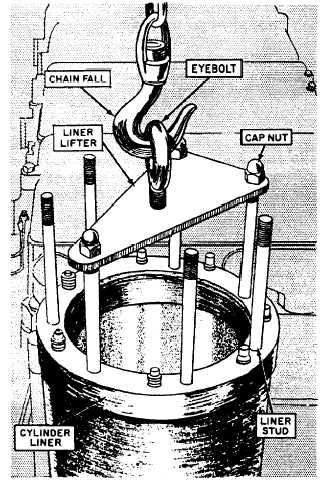Figure 3-9.—Removing a cylinder liner.
4. Attach the special liner puller to the liner studs
and tighten the nuts by hand. (The nuts must be hand
tightened; if a wrench is used, the threads on both the
nuts and the studs may be damaged.)
5. Attach the hook of the chain fall and pull slightly
until the liner breaks free (fig. 3-9). If the liner fails to
break loose immediately, apply pressure at the bottom
of the liner. To do this, place a block of wood on the
crankshaft throw, and force it up against the liner by
rotating the turning gear.
6. Lift the liner up until it clears the top of the
engine block and remove it to a safe place. You may need
to rotate the liner slightly while removing it from the
engine block.
INSPECTING, TESTING, AND
REPAIRING CYLINDER HEADS
Conditions requiring repair of a cylinder head are
similar to those for cylinder liners and can be grouped
under cracks, corrosion, distortion, and fouling.
CRACKS
The symptoms of a cracked cylinder head are the
same as those of a cracked liner. Cracks in cylinder
heads are best located by either visual inspection or
magnetic powder inspection. On some types of engines,
a defective cylinder can be located by bringing the
piston of each cylinder, in turn, to top dead center and
applying compressed air. When air is applied to a
damaged cylinder, a bubbling sound indicates leakage.
When the cylinder head is removed from the engine,
it can be checked for cracks by the hydrostatic test used
on cylinder liners equipped with integral cooling
passages.
Cracks generally occur in cylinder heads on the
narrow metal sections between such parts as valves and
injectors. The cracks may be caused by adding cold
water to a hot engine, by restricted cooling passages, by
obstructions in the combustion space, or by improper
tightening of studs.
Aboard ship, cracked cylinder heads usually must
be replaced. It is possible to repair them by welding, but
this process requires special equipment and highly
skilled personnel normally found only at repair
activities.
CORROSION
Burning and corrosion of the mating surfaces of a
cylinder head may be caused by a defective gasket.
Although regular planned maintenance ordinarily
prevents this type of trouble, burning and corrosion may
still take place under certain conditions. When corrosion
and burning occur, there may be a loss of power due to
combustion gas leakage out of or water leakage into the
combustion space. Other symptoms of leakage may be
(1) hissing or sizzling in the head where gases or water
may be leaking between the cylinder head and the block,
(2) bubbles in the cooling water expansion tank sight
glass, or (3) overflow of the expansion tank.
Gaskets and grommets that seal combustion spaces
and water passages must be in good condition; otherwise
the fluids will leak and cause corrosion or burning of the
area contacted. Improper cooling water treatment may
also accelerate the rate of corrosion.
In general, cylinder heads that are burned or
corroded by gas or water leakage are so damaged that
they must be replaced.
3-7

